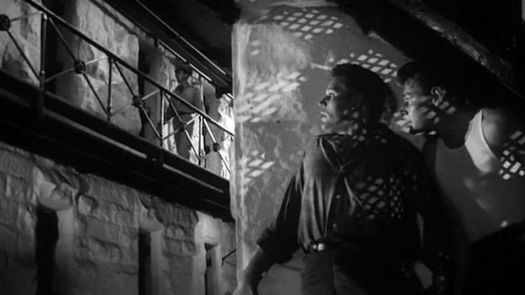Back in 1951, movie producer Walter Wanger (rhymes with danger) discovered his wife, actress Joan Bennett , was having an affair with her agent, Jennings Lang. The enraged husband tracked them to a parking lot, where Wanger shot Lang in the groin. That’ll teach him! Wanger was subsequently arrested, and sentenced to serve a four-month bid in a Los Angeles county farm. His stint in stir, though brief, affected him profoundly, and he wanted to make a film about prison conditions. The result was RIOT IN CELL BLOCK 11, a ripped-from-the-headlines prison noir that’s tougher than a two-dollar steak.
Wanger hired Don Siegel to direct the film. Siegel was gaining a reputation as a director of muscular, low-budget features, and RIOT IN CELL BLOCK 11 is a great early example of his harsh, brutal style. The movie’s sparse, shadowy setting was filmed on location at California’s infamous Folsom Prison thanks to the connections of one of Siegel’s assistants, a young man working on his first film named Sam Peckinpah . Gee, I wonder whatever became of him?
RIOT IN CELL BLOCK 11 opens with narrator James Matthews intoning ominous newsreel footage of prison riots across the USA protesting inhumane conditions. We then turn to our fictional prison, where a single mistake by a rookie guard leads to chaos in Cell Block 11, led by hardened cons Dunn (Neville Brand ) and Carnie (Leo Gordon). They take over the solitary confinement block, using four guards as hostages, and trash the place. The warden (Emile Meyer) is called in as the inmates present their demands, and insist the press be alerted as well.
The entire prison devolves into chaos and rioting, and the state police are called in to quell things with smoke bombs and rubber bullets. An inmate is accidentally killed during the commotion, and five other guards are snatched by the cons. The warden hears Dunn’s demands: remodel the condemned solitary block, separate “the nuts” (those with mental health issues) from the other cons, get rid of leglocks and overzealous guards, teach the men a trade, and absolutely no reprisals for the rioters.
The warden has been asking for some of these same changes for years, but his pleas have fallen on deaf ears. He’s willing to sign off on them now, but the governor (Thomas Henry Browne) refuses, and the prison commissioner (Frank Faylen) orders TNT to be planted on the outside wall of the cell block. Meanwhile, warring factions in the cell block leave Dunn injured, and his lieutenant “Crazy Mike” Carnie takes command. Carnie plans to begin killing hostages, but when the commissioner’s plot is discovered, they chain the hostages to a pipe on the other side of the wall. Dunn recuperates just in time to take a phone call from the warden: the governor has relented, and the prisoner’s demands for change will be met. But two weeks later, it turns out it was all for naught. The state legislature repudiates the warden’s and governor’s signatures, and Dunn is to stand trial for leading a riot and kidnapping the guards. Though Carnie and some of the other “nuts” are sent to the State Mental Institution, the rest of the demands will not be met.
The cast of RIOT IN CELL BLOCK 11 consists of some legitimate hard guys. Neville Brand was a highly decorated soldier during World War II, earning a Purple Heart, Silver Star, three Bronze Stars, and six other medals for bravery and valor in combat. Leo Gordon was thrown out of the Army, and later served five years in San Quentin for armed robbery. The warden of Folsom reused to let Gordon in at first, but Siegel, who once called Gordon “the scariest man I have ever met”, talked him into it. Among the cons, guards, and reporters, you’ll find Familiar Faces like Whit Bissell (whose first credited role was in BRUTE FORCE ), Roy Glenn, Dabbs Greer (whose final film appearance was in THE GREEN MILE), Frank Hagney, Jonathan Hole, Alvy Moore , William Phipps, William Schallert , and Carleton Young. Some of the actual Folsom cons and guards appear as extras.
RIOT IN CELL BLOCK 11 tells a very bleak tale of desperate people driven to desperate measures. It’s lean and mean, like the best films noir, and delivers it’s message with sledgehammer potency. This compact diamond-in-the-rough is among director Siegel’s best work, and is highly recommended by yours truly.






Reblogged this on Through the Shattered Lens.
LikeLike
You’ve sold me! I want to see this movie.
LikeLiked by 1 person
Well worth it!
LikeLike